ZekeFilm Salutes Cinema’s Favorite Everyman
For our second Film Admissions article this May, we at ZekeFilm have a special treat in store: our contributor’s reactions to previously unseen movies starring James Stewart!
Following longtime friend Henry Fonda to Hollywood in 1935 as a contract player for MGM Studios, Stewart began his film career playing charming, boyish second leads in films like Rose Marie (1936), Wife vs. Secretary (1936), and (rather surprisingly) After the Thin Man (1936). From the beginning, though, something was a little different about this tall and gangly, near-handsome performer; a bit, if you will, “off”: he stammered, he blushed, he shuffled his feet. In other words, from his earliest and smallest roles, Stewart had the considerable talent to appear embarrassingly “real” and vividly “himself” on-screen.
 Roles (and billing) improved for Stewart over the next few years, refining his screen persona under the guidance of veteran directors like Clarence Brown and W. S. Van Dyke, until a loan-out to rival studio Columbia Pictures in 1938 resulted in Stewart being cast in the role of “Tony Martin” in Frank Capra’s movie adaptation of the Broadway smash You Can’t Take It With You. Now a certified star, Stewart continued his success in a second film for Frank Capra, Mr. Smith Goes To Washington (1939), Ernst Lubitsch’s The Shop Around the Corner (1940), and, another adaptation of a Broadway smash, George Cukor’s The Philadelphia Story (1940), for which Stewart won his first (and only) Academy Award.
Roles (and billing) improved for Stewart over the next few years, refining his screen persona under the guidance of veteran directors like Clarence Brown and W. S. Van Dyke, until a loan-out to rival studio Columbia Pictures in 1938 resulted in Stewart being cast in the role of “Tony Martin” in Frank Capra’s movie adaptation of the Broadway smash You Can’t Take It With You. Now a certified star, Stewart continued his success in a second film for Frank Capra, Mr. Smith Goes To Washington (1939), Ernst Lubitsch’s The Shop Around the Corner (1940), and, another adaptation of a Broadway smash, George Cukor’s The Philadelphia Story (1940), for which Stewart won his first (and only) Academy Award.
World War II broke out just as Stewart’s contract with MGM expired, and Stewart’s enlistment in the United States Army Air Force in 1941 – as a private – put his movie career on hold for the duration of the war. During his service, Stewart rose to Squadron Commander and the rank of Major, flying dangerous bombing missions over key military targets in Germany, returning to Hollywood with his third and final film for Frank Capra, It’s A Wonderful Life, in 1946. A box-office failure in its original run, Stewart’s brilliant portrayal of beleaguered, small-town banker “George Bailey” added a previously-unseen depth and maturity to his performance style.
Stewart’s war-time service definitely informed the complexity and depth of roles he sought in the late 40s through the 1950s, and it was during this period that Stewart became closely associated with two genres far-removed from his pre-war light comedies: particularly, the Western and the thriller. Two important collaborations for Stewart during this period were with directors Anthony Mann – with whom he made five Westerns, including Winchester ’73 (1948) and Bend of the River (1952) – and “Master of Suspense”, Alfred Hitchcock – with whom he made four thrillers, including Rear Window (1954) and Vertigo (1958). His performance from this period as home-spun attorney “Paul Biegler” in Otto Preminger’s Anatomy of a Murder (1959), deceptively folks-y and drawlingly canny, is possibly his very best.
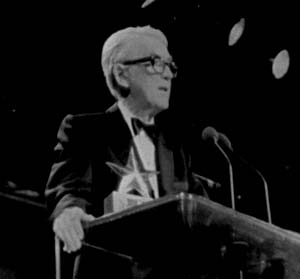 From his late-night appearances on The Tonight Show with Johnny Carson – often reading poetry of his own composition in his oft-imitated, but never-equaled, distinctive drawl – to his humble, gracious, and self-deprecating acceptance speech for an AFI Lifetime Achievement Award in 1980, Stewart remained charmingly awkward and humorously “himself”, a quality that comes through in every role he played.
From his late-night appearances on The Tonight Show with Johnny Carson – often reading poetry of his own composition in his oft-imitated, but never-equaled, distinctive drawl – to his humble, gracious, and self-deprecating acceptance speech for an AFI Lifetime Achievement Award in 1980, Stewart remained charmingly awkward and humorously “himself”, a quality that comes through in every role he played.
To test that thesis, then, sit back and enjoy our contributor’s initial, uh, as it were, um, first-time reactions [awkward pause, blink] to a couplefew classics (yup, mighty important-sounding word, that) from our Film Admissions‘ series second star of the month, Jimmy Stewart!
Destry Rides Again
(1939, Universal Pictures, Dir. George Marshall)
by Randall Yelverton
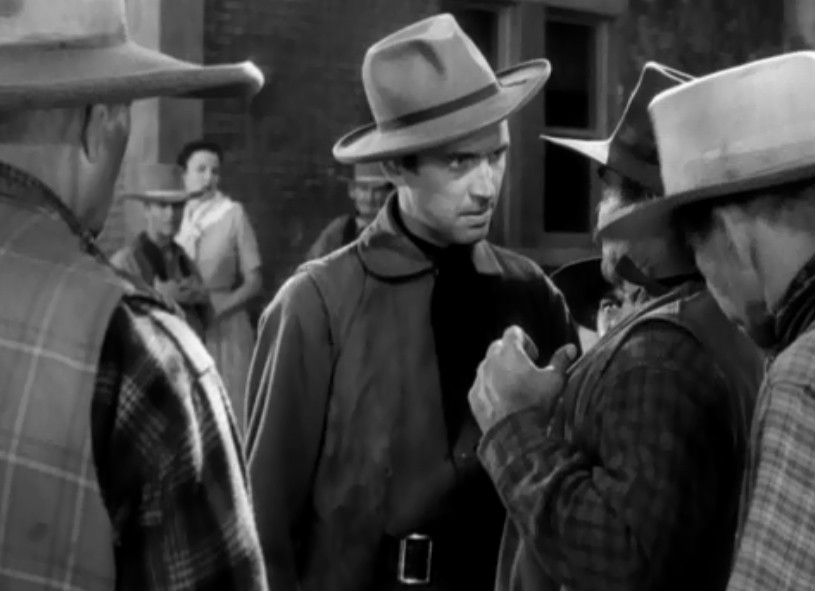 It’s interesting to watch Destry Rides Again (1939), a Jimmy Stewart Western comedy about a lawless town, with two other comedies in mind: the wildly uneven, but much loved Blazing Saddles (1974), which owes a great deal to the Stewart film and featured Madeline Kahn parodying Marlene Dietrich’s chanteuse role in Destry, and A Million Ways to Die in the West(2015) which was Seth MacFarlane’s poor attempt to make his own Blazing Saddles. These Western comedies can both trace their lineage to Destry, but the 1939 film far exceeds its progeny. Modern viewers may be conditioned to believe that a Western comedy should be a groan-inducing joke machine, but Destry Rides Again succeeds as a both a compelling Western and a very funny film. Its laughs are character-based and advance the plot instead of stopping it in its tracks.
It’s interesting to watch Destry Rides Again (1939), a Jimmy Stewart Western comedy about a lawless town, with two other comedies in mind: the wildly uneven, but much loved Blazing Saddles (1974), which owes a great deal to the Stewart film and featured Madeline Kahn parodying Marlene Dietrich’s chanteuse role in Destry, and A Million Ways to Die in the West(2015) which was Seth MacFarlane’s poor attempt to make his own Blazing Saddles. These Western comedies can both trace their lineage to Destry, but the 1939 film far exceeds its progeny. Modern viewers may be conditioned to believe that a Western comedy should be a groan-inducing joke machine, but Destry Rides Again succeeds as a both a compelling Western and a very funny film. Its laughs are character-based and advance the plot instead of stopping it in its tracks.
Destry Rides Again opens with a funny credits sequence that establishes the town of Bottleneck is an anarchic mess plagued by constant gunfire and drunken brawls. After this opening, the film settles in to a thrilling scene of treachery as we are introduced to the villain Kent (Brian Donlevy) who is cheating the people of Bottleneck out of their land and livelihoods. He’s a real menace and never becomes a figure of derision. When James Stewart’s law man arrives to clean up the town, the ironic pairing of his “aw shucks” demeanor with his cunning mind provides the audience with laughs, but the menace of Kent is lurking constantly throughout the film. He’s an evil man who brings much heartache to Stewart before the film ends. The film works as a gripping narrative first and foremost, and the laughs never extinguish the menace threatening Stewart and the film’s other heroes. This is a very funny film—the climax is a hilarious slapstick free for all that must be seen—but the laughs are quickly tempered by thrills and tragedy. This successful mix of tones is a wonder to behold and puts its Western comedy imitators to shame.
Mr. Smith Goes to Washington
(1939, Columbia Pictures, Dir. Frank Capra)
by Krystal Lyon
 So the purpose of these Film Admissions is to admit to an important film that you might have missed in an acclaimed actor or actress’s career, and if you haven’t missed any of the big ones then it gives you a great chance to watch a hidden gem or analyze a misstep by said performer. Well, for me I’m basically getting an education in film because I have seen very few great classic films. I have a lot to learn and a lot to watch! All this to say I had the privilege to watch the classic Mr. Smith Goes to Washington for the first time this week. What a gift of a film and performance, no wonder it was nominated for 11 Academy Awards! I could talk about Frank Capra and his remarkable style for days! And did you know this is based on a true story and I have a friend who knows the woman who married the real Mr. Smith? (She’s 101 years old.) Then there’s the drama that unraveled because of the politics of the film during the beginning of WWII. Whether it’s Frank Capra or Frank Underwood we love to look at the underside of politics. All of these would make great points to discuss but because this is collaborative effort and there are other films to consider let’s look at Stewart’s performance and how this film changed his career.
So the purpose of these Film Admissions is to admit to an important film that you might have missed in an acclaimed actor or actress’s career, and if you haven’t missed any of the big ones then it gives you a great chance to watch a hidden gem or analyze a misstep by said performer. Well, for me I’m basically getting an education in film because I have seen very few great classic films. I have a lot to learn and a lot to watch! All this to say I had the privilege to watch the classic Mr. Smith Goes to Washington for the first time this week. What a gift of a film and performance, no wonder it was nominated for 11 Academy Awards! I could talk about Frank Capra and his remarkable style for days! And did you know this is based on a true story and I have a friend who knows the woman who married the real Mr. Smith? (She’s 101 years old.) Then there’s the drama that unraveled because of the politics of the film during the beginning of WWII. Whether it’s Frank Capra or Frank Underwood we love to look at the underside of politics. All of these would make great points to discuss but because this is collaborative effort and there are other films to consider let’s look at Stewart’s performance and how this film changed his career.
Stewart was made for the role of Jefferson Smith, the everyday man that’s amazed by the Capitol Dome. Capra originally wanted Gary Cooper to play Mr. Smith but Stewart’s naive and lanky “Aw Shucks!” demeanor demonstrated in You Can’t Take It With You won Capra over. “I knew he would make a hell of a Mr. Smith!” Capra said, “He looked like the country kid, the idealist. It was very close to him.” Jean Arthur, who played Clarissa Saunders in Mr. Smith, later recalled that Stewart didn’t want one thing to go wrong because he knew it was the role of a lifetime. “He used to get up at five o’clock in the morning and drive himself to the studio. He was so terrified something was going to happen to him, he wouldn’t drive faster.” All that caution, whether it was needed or not, worked and Stewart became the ultimate underdog fighting against big money and corrupt politics! The role of Mr. Smith gave Stewart his first Academy Award nomination and while he did not win, he won the following year for The Philadelphia Story. (PS… Stewart’s Mr. Smith was up against Mickey Rooney- Babe in Arms, Laurence Olivier- Wuthering Heights, Clark Gable- Gone With the Wind and Robert Donat who won for his role in Goodbye, Mr. Chips for the 1940 Academy Award. That’s some serious competition and what a fantastic year for film!)
All the fanfare aside, Mr. Smith Goes to Washington made me cry, laugh and smile at 2:00 o’clock in the morning! You can’t help but smile when young Mr. Smith gets caught off guard by the glory of Washington DC and wanders off, blowing off duties and senators. You can’t help but laugh when all of Governor Hopper’s children won’t stop singing the praises of Jefferson Smith around the dinner table and are bossing their father around just as much as the politicians in DC. And if you can hold it together during the filibuster scene then you’re made of stone! “I guess this is just another lost cause, Mr. Paine. All you people don’t know about lost causes. Mr. Paine does. He said once they were the only causes worth fighting for. And he fought for them once, for the only reason any man ever fights for them; because of just one plain simple rule: ‘Love thy neighbor.’” These lines are well written but it’s Stewart’s delivery, his very character that grips your heart and makes you hope for men like Jefferson Smith to truly lead our country.
Harvey
(1950, Universal International Pictures, Dir. Henry Koster)
by Robert Hornak
 Harvey’s built up quite a head of comic steam in my mind over the years that I’ve put off actually watching it. But I could only really get into it about half way through, when I accepted that it isn’t exactly the comedy everyone told me it was. While plotted like a comedy and populated with comic characters, there’s simply something else going on that isn’t really all that funny, possibly creepy, a darkness unintended. Maybe I can blame all those Hitchcock and Mann movies Stewart painted himself black with during the decade after Harvey for retro-informing my take on his character. Or maybe I can blame the last sixty-five years of culture moving away from embracing the tipsy, Thin Man-esque consta-drunk. Or maybe I can blame Stewart himself for not really playing a drunk at all, but his usual confident, clear-eyed self, only this time cavorting with, you know, an invisible, six-foot rabbit – a bizarre incongruence that, for this first time viewer, sparks an unexpected creepiness. With his head seemingly as level as ever, watching Stewart watching other people’s reactions to him as he introduces them to his big imaginary friend, his typical smiling geniality mixed with some unnamable expectation, is like watching a darkly cruel psychologist probing a man on the street for his reaction to a friendly slap in the face. I can hear Stewart’s laconic drawl now, accompanied by his preternaturally charming, leaned-forward twinkle: “Now, tell me, w-what’ja think of that?”
Harvey’s built up quite a head of comic steam in my mind over the years that I’ve put off actually watching it. But I could only really get into it about half way through, when I accepted that it isn’t exactly the comedy everyone told me it was. While plotted like a comedy and populated with comic characters, there’s simply something else going on that isn’t really all that funny, possibly creepy, a darkness unintended. Maybe I can blame all those Hitchcock and Mann movies Stewart painted himself black with during the decade after Harvey for retro-informing my take on his character. Or maybe I can blame the last sixty-five years of culture moving away from embracing the tipsy, Thin Man-esque consta-drunk. Or maybe I can blame Stewart himself for not really playing a drunk at all, but his usual confident, clear-eyed self, only this time cavorting with, you know, an invisible, six-foot rabbit – a bizarre incongruence that, for this first time viewer, sparks an unexpected creepiness. With his head seemingly as level as ever, watching Stewart watching other people’s reactions to him as he introduces them to his big imaginary friend, his typical smiling geniality mixed with some unnamable expectation, is like watching a darkly cruel psychologist probing a man on the street for his reaction to a friendly slap in the face. I can hear Stewart’s laconic drawl now, accompanied by his preternaturally charming, leaned-forward twinkle: “Now, tell me, w-what’ja think of that?”
I admit I’ve broken that rule-number-one of criticism: analyze in the context of the film’s time. Too late, Stewart’s cumulative screen persona is too strong. I just can’t believe that the same man who traced the anatomy of a murder, if you will, or carefully wheedled his way into vertiginous love with a fake blonde, or accomplished so much over so many movies with his probing humor, can be so farbehind the other characters that they’re the ones tip-toeing around his dementia. This may be the only movie of his that asks that of me. I can only respond like I do in every other one of his movies: trust he’s doing the right thing for the right reason…or that he’s going to learn that his way was the wrong way the whole time.
Or maybe it’s more like this. Most Jimmy Stewart movies are some kind of balance between the two stammering halves of the brand JIMMY STEWART: the yearning, sweet-souled, righteous bumpkin who’s everybody’s earnest best friend, and the taciturn missionary – world-weary – trying to hang onto a shred of moral decency while screeching at Injustice with that patented righteous drawl and/or pounce-ready anger-panic – face like a big white knuckle. I believe we respond to the first because it’s who we want ourselves (or our nation) to be, and we respond to the second because we know how he feels and we wish we could airlift him out of the movie before he breaks into too many pieces. He’s both in most movies to some degree, often traveling the gamut from one to the other (as in Mr. Smith Goes To Washington) – and it’s the combo that makes him three-dimensional, time-proof. But in Harvey, he’s all-likable-all-the-time, without a single dark quiver from behind the rosy glasses (a tremendous testament to his high-wire skill), and it finally got to me – I decided the darker Stewart had to be there, he was just keeping it so deep beneath his vest…that only I could see it. He must be putting everyone on – cause Jimmy Stewart’s too smart to be so delusional!
I guess my boiled-down bottom is this: what I got from Harvey isn’t “Sweet, lovable Elwood P. Dowd doesn’t realize the trail of confusion his steadfast loyalty to an invisible rabbit is creating behind him, and isn’t that funny!” but instead “Either Elwood P. Dowd is a mischievous prankster lording it silently over all the suckers, or he’s exactly who he presents himself to be, in which case he’s happily chained to his very own Babadook, and isn’t that horrifying.”
Thunder Bay
(1953, Universal International Pictures, Dir. Anthony Mann)
by Justin Mory
 Stewart, always credited as “James”, will invariably be “Jimmy” to his fans. Can you think of any other star of his time who was on terms of such familiarity with his audience? I can’t. Even Gary Cooper and Henry Fonda were every-so-slightly more ‘larger than life’ in their all-American roles.
Stewart, always credited as “James”, will invariably be “Jimmy” to his fans. Can you think of any other star of his time who was on terms of such familiarity with his audience? I can’t. Even Gary Cooper and Henry Fonda were every-so-slightly more ‘larger than life’ in their all-American roles.
The ultimate in screen approachability stammered and charmed his way through over 55 years of movie history – from 1935’s The Murder Man to his voice role in 1991’s An American Tail: Fievel Goes West; essaying immortal screen Everymen such as Jefferson Smith, George Bailey, and Elwood P. Dowd in-between – and still tops lists as the best male leading actor Hollywood ever produced. Why? Possibly because unlike every big star you’d like to know, Jimmy Stewart is the one big star that you actually do know.
Knowing, then, that there is a core of decency to practically every role Stewart ever played (well, perhaps with the surprising exception of his part in 1936’s After the Thin Man!), it is interesting to watch his choice of roles deepen and darken in the years after World War II, most notably in the films of Alfred Hitchcock and, for the purposes of this entry, action and Westerns auteur Anthony Mann. In his 8-film collaboration with director Mann, starting with 1948’s Winchester ’73, Stewart, particularly in their Westerns made together, played morally-compromised figures motivated largely by revenge.
For audiences and Stewart fans in 2015, though, perhaps the biggest (unintentional) shock might come from viewing his and Mann’s first non-Western collaboration, 1953’s Thunder Bay. Though set in 1945 Louisiana, the movie retains some of the features of the Westerns Mann and Stewart made together – the self-driven, obsessive character played by Stewart, especially – but does something many latter-day viewers might find vaguely uncomfortable: it makes a hero out of an oilman! Light-years removed from Daniel Day-Lewis’s “Daniel Plainview” in 2007’s There Will Be Blood, Stewart’s latter-day ‘wildcatting’ prospector pioneers offshore drilling in the Gulf of Mexico and, against all movie odds, saves a big oil company, overcomes the hostile resistance of the local shrimpers, and even gets the girl (Joanne Dru).
No comment on this end, but only Stewart and his considerable screen appeal could overcome this film fan’s personal resistance to imagining the 60-years-after “sequel,” as it were, to Stewart’s on-screen “heroics”!
The Naked Spur
(1953, MGM, Dir. Anthony Mann)
by Sharon Autenrieth
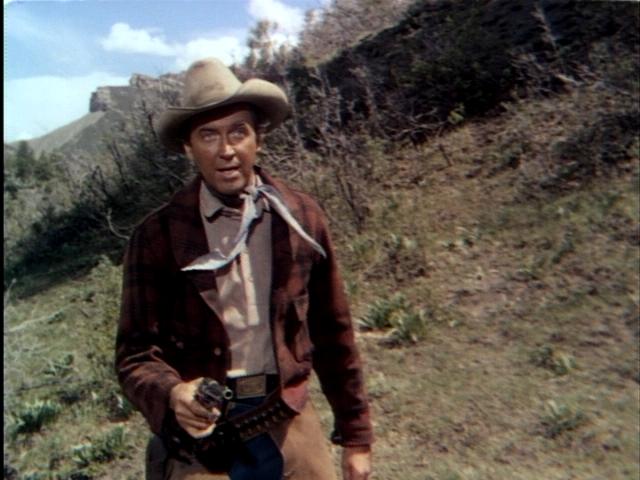 Jimmy Stewart made three movies with Frank Capra, four with Alfred Hitchcock, but eight with Anthony Mann – including five Westerns. Mann may be less well known than Capra or Hitchcock, but those westerns helped to revive and redefine Stewart’s career. Stewart could always bring darkness to his roles, but with Mann the darkness was often front and center.
Jimmy Stewart made three movies with Frank Capra, four with Alfred Hitchcock, but eight with Anthony Mann – including five Westerns. Mann may be less well known than Capra or Hitchcock, but those westerns helped to revive and redefine Stewart’s career. Stewart could always bring darkness to his roles, but with Mann the darkness was often front and center.
In The Naked Spur Stewart is Howard Kemp, hunting for a murderer, not in pursuit of justice but for the reward. He captures his prey, a gleeful Robert Ryan, but only by reluctantly taking on a couple of partners – Millard Mitchell, as a perpetually unlucky prospector and Ralph Meeker as an amoral dishonarably-discharged army officer. Ryan has a partner, too: Janet Leigh as a young woman whose loyalties are misplaced.
It’s slow, calculating psychological warfare between Ryan, Meeker and Stewart. Kemp is deeply damaged by a betrayal he suffered and is determined to buy back the land he lost. Roy (Meeker) wants his share of the money – and perhaps the girl. Ben (Ryan) just wants to turn his captors against each other to better his odds for escape.
Jimmy Stewart made for an unusual Western anti-hero. His gangly frame never seems a match for his adversaries, his voice becomes querulous with stress or fear, and when he cries out in pain it’s a piercing, animal-like scream. His facial expressions are wary, anxious, paranoid- all of which works well in a movie like this where no one can be trusted. It will take the entire movie to sort out whether there is still a good man beneath Kemp’s bitter obsession – but not without shifting alliances and considerable violence. Stewart was a beloved movie star, but with Mann he was willing and able to let audiences see him in a very different, much harsher light.
The Man from Laramie
(1955, Columbia Pictures, Dir. Anthony Mann)
by Jim Tudor
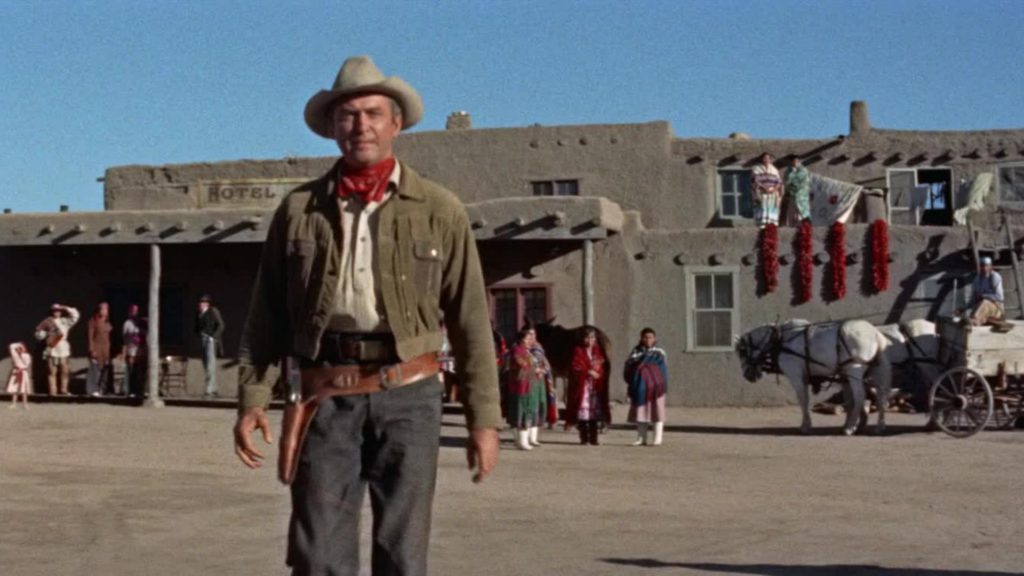 For those who know James Stewart only for his affable stammering Everyman persona, the string of films he made in the 1950s with director Anthony Mann will likely come as quite a shock. Primarily Westerns, these films radiated a certain unique psychological heat all their own. Rarely is Stewart’s character okay in these movies. For 1955’s The Man from Laramie, their fifth and final Western pairing, Mann dragged Stewart through the fire – literally.
For those who know James Stewart only for his affable stammering Everyman persona, the string of films he made in the 1950s with director Anthony Mann will likely come as quite a shock. Primarily Westerns, these films radiated a certain unique psychological heat all their own. Rarely is Stewart’s character okay in these movies. For 1955’s The Man from Laramie, their fifth and final Western pairing, Mann dragged Stewart through the fire – literally.
As his small fleet of three carts and the mules to haul them are senselessly destroyed by a local megalomaniac, Stewart’s character Will Lockhart (a telling name if there ever was one) is roped and dragged across his own campfire, arriving at the focal foreground, selling that it really was James Stewart the whole time, and not a double. If Mann/Stewart veterans hadn’t realized the lengths that actor would go for the director, this moment sears it. Stewart plays a former Calvary man, a loner, the titular Man From Laramie. Except, he’s not. That’s what he says, anyhow. His backstory is about as clear as his motive, which he keeps tucked away in dark parts of his soul, which peak out less in this Mann Western than some of their others.
Time and again, Mann boldly redefined Stewart on screen. His Westerns have an internal unease that transcend much of the then-intensely popular genre at the time, every moment intentionally crafted as such. Second only to John Ford and perhaps on the level of Howard Hawks as a Western director, Mann knew how to meld America’s internal unease with the terrain by which we define ourselves. It is beautiful and majestic, but rough and deadly all the same. Stewart’s character is the kind of blank slate we relate to, and need. In the same era, Hitchcock would more famously and more mischievously tweak the actor’s persona. But with Mann, there’s something base-level American, both positive and negative. Early on, the director gives Stewart a long, magnificent tracking shot as the actor strides toward the source of his ire. No dialogue, no cutaways. There’s just James Stewart, owning this dusty settlement he’d only recently arrived at. The look in his steely eyes tells us all we need to know, his bag of “Jimmy Stewart” stammering tricks burned up in those carts – at least for now.
I used to say that the best thing about the exceptional run of Mann/Stewart Westerns was that there was always another one to see. As of this screening, that is no longer the case for me. That makes finally seeing it a bittersweet moment, not unlike the way of things in The Man from Laramie.
Vertigo
(1958, Alfred J. Hitchcock Productions, Dir. Alfred Hitchcock)
by Erik Yates
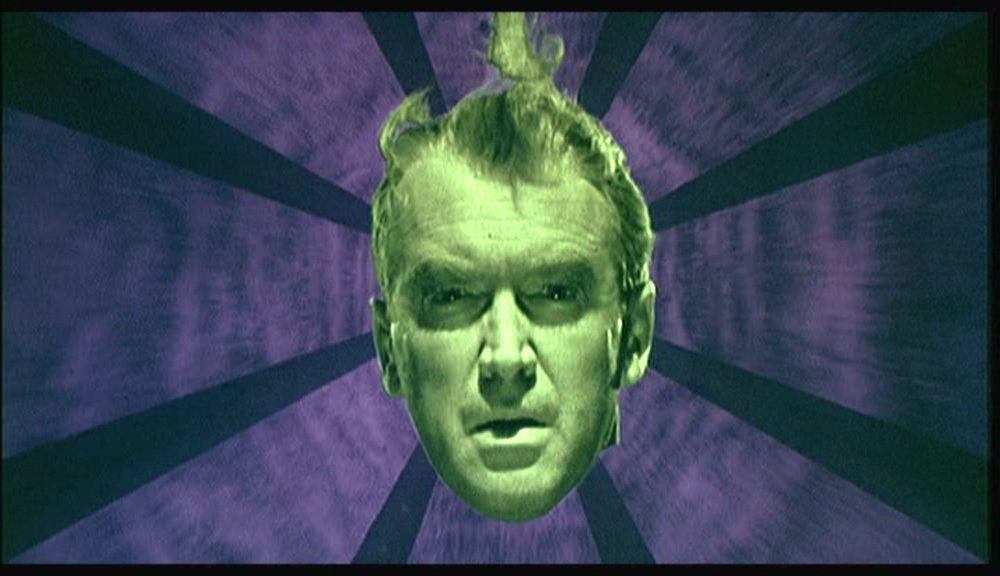
I may be one of the only ones in the world who, until recently, had not seen Alfred Hitchcock’s tour de force, Vertigo. Having recently placed ahead of Citizen Kane in a prestigious “best of” list, this is undoubtedly a glaring admission of which I no longer have to be ashamed of. Hitchcock favorite Jimmy Stewart plays a police detective who undergoes a trauma while chasing a suspect that renders him unable to deal with heights without getting frozen in fear. Having resigned the force, Stewart picks up work as a private eye following around his friend’s wife to see if she needs to be committed to a psychiatric unit. Hitchcock directs this story as a routine investigation, with familiar formulas such as Stewart’s character falling for the girl that he is supposed to be watching.
Many of Hitchcock’s characters are morally flawed, and just when you think you’ve figured out where the story is going to go, he drops the other shoe and gives the story a giant twist. Complete with a spinning, floating green-headed Stewart mesmerizing the screen, this film is a classic in every sense of the word. It’s biggest feat may not be the mystery and plot twists but the way Hitchcock is able to take the pristine all-American reputation of Stewart from such classics as It’s a Wonderful Life and Mr. Smith Goes to Washington, and dirty him up the way he does in Vertigo, and even Rear Window. I’m happy to say that I’ve finally seen this classic film and no longer need to be ashamed!


